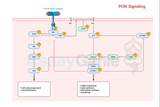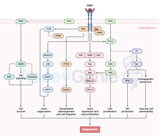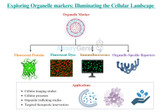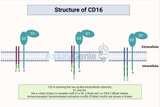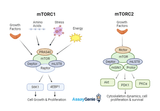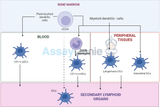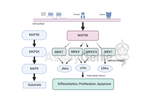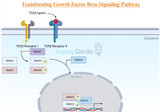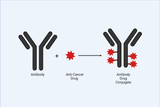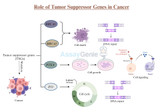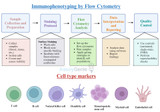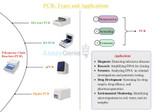Blog
MAPK Signaling in Inflammatory Cytokines Pathways
The Mitogen-Activated Protein Kinase (MAPK) pathway is a pivotal signaling cascade that plays a crucial role in mediating cellular responses to various external stimuli. This pathway is intricately involved in the regulation of inflammatory cytokines, key signaling molecules in the immune system. Understanding the MAPK signaling pathway in the context of inflammatory cytokines is essential for grasping the molecular basis of inflammation and its related disorders. Overview of MAPK Signaling Fundamental Components and Activation: MAPK signaling encompasses a series of protein kinases that transmit signals from the cell surface to the nucleus. These kinases include the Extrac
…
22nd Jan 2024
JAK-STAT Signaling Pathway: A Comprehensive Exploration
window.SHOGUN_IMAGE_V2_ELEMENTS = window.SHOGUN_IMAGE_V2_ELEMENTS || new Array();
window.SHOGUN_IMAGE_V2_ELEMENTS.push({ uuid: 's-45124fd5-9a75-444d-b680-b8339e2a814d' })
Progression of the JAK STAT Signalling Pathway Cellular communication is a complex network of molecular interactions that govern various physiological processes. Among the many signaling pathways, the Janus kinase-signal transducer and activator of transcription (JAK-STAT) pathway plays a pivotal role in mediating signals from the cell surface to the nucleus. This pathway is essential for regulating immune responses, cell proliferation, differentiation, and survival. In this article, we will delv
…
18th Jan 2024
MAPK Oxidative Stress Pathway: A Journey through Cellular Signaling
window.SHOGUN_IMAGE_V2_ELEMENTS = window.SHOGUN_IMAGE_V2_ELEMENTS || new Array();
window.SHOGUN_IMAGE_V2_ELEMENTS.push({ uuid: 's-e5394be4-6636-4558-9e32-20ef2f209b2b' })
In the intricate world of cellular signaling, the Mitogen-Activated Protein Kinase (MAPK) pathway plays a pivotal role in regulating various cellular processes. One facet of this pathway that has garnered significant attention is its involvement in managing oxidative stress—a condition marked by an imbalance between reactive oxygen species (ROS) and the cell's antioxidant defense mechanisms. In this article, we embark on a journey through the MAPK oxidative stress pathway, exploring its intri
…
18th Jan 2024
Adipokines and Insulin Signaling Pathways: An In-Depth Exploration
The prevalence of obesity and its associated metabolic disorders has risen dramatically in recent decades, presenting a significant global health challenge. Adipose tissue, once considered merely a storage site for excess energy, is now recognized as an active endocrine organ secreting a myriad of bioactive molecules known as adipokines. Among these adipokines, a key player in metabolic regulation is insulin, a hormone produced by the pancreas. Adipokines: Key Regulators of Metabolism Adipokines function as critical mediators between adipose tissue and various organs, influencing metabolic processes such as glucose homeostasis, lipid metabolism, and inflammation. Lep
…
18th Jan 2024
VEGF-A VEGFR-2 Signaling: Decoding the Blueprint of Angiogenesis for Therapeutic Insights
The orchestration of angiogenesis, the process by which new blood vessels form from pre-existing ones, is a complex symphony regulated by various molecular players. At the forefront of this intricate dance is the VEGF-A VEGFR-2 signaling pathway, a pivotal mechanism that propels the growth and maintenance of blood vessels. In this comprehensive exploration, we delve into the molecular details of this pathway, shedding light on its fundamental role in angiogenesis and its implications in both health and disease. VEGF-A: A Master Regulator of Angiogenesis: Vascular Endothelial Growth Factor A (VEGF-A) stands as a beacon among the VEGF family of growth factors. Produced
…
18th Jan 2024
Unraveling the Complexity of the Notch Signaling Pathway: A Key Player in Development and Disease
The Notch signaling pathway is a highly conserved cellular communication system that plays a crucial role in various biological processes, including embryonic development, tissue homeostasis, and immune system function. Discovered over a century ago, the Notch pathway has since emerged as a complex and versatile signaling network that regulates cell fate decisions and maintains tissue integrity. This article aims to provide an overview of the Notch signaling pathway, its components, and its diverse roles in development and disease. Basic Components of the Notch Signaling Pathway: The Notch pathway consists of a family of transmembrane receptors, known as Notch receptors, a
…
17th Jan 2024
Unlocking Cellular Adaptation: The HIF Enhancer Pathway and Its Implications in Hypoxia Response
Hypoxia, or low oxygen levels, poses a significant challenge to cells, necessitating rapid and efficient adaptation mechanisms. The Hypoxia-Inducible Factor (HIF) pathway is a well-known regulator of cellular responses to hypoxia, orchestrating the expression of genes involved in angiogenesis, erythropoiesis, and glycolysis. It plays a pivotal role in cellular adaptation to low oxygen conditions, ensuring survival and homeostasis in diverse physiological and pathological settings. Recent studies have uncovered an additional layer of complexity in HIF regulation, known as the HIF enhancer pathway. This article explores the mechanisms, regulation, and significance of the HIF enhancer pa
…
12th Jan 2024
Exploring Organelle Markers: Illuminating the Cellular Landscape
The eukaryotic cell is a complex and dynamic system with distinct membrane-bound compartments known as organelles, each performing specialized functions essential for cellular survival. To better understand the intricate workings of these organelles, scientists employ organelle markers – molecular tools that provide a means to visualize and study these structures. In this article, we delve into the fascinating realm of organelle markers, discussing their significance, types, and applications in unraveling the mysteries of cellular biology. Organelle Markers: Painting a Molecular Canvas Organelle markers play a pivotal role in cell biology research by allowing scientists to
…
11th Jan 2024
Understanding CD16: A Comprehensive Overview
CD16, also known as FcγRIII (Fc gamma receptor III), plays a crucial role in the immune system, serving as a receptor for the Fc region of immunoglobulin G (IgG). This receptor is a key player in mediating various immune responses and has implications in both innate and adaptive immunity. In this article, we will delve into the structure, functions, and significance of CD16 in the context of immune regulation. Key Takeways CD16, also known as FcγRIII, is crucial in both innate and adaptive immunity. There are two isoforms: CD16A on NK cells, macrophages, and neutrophils, and CD16B mainly on neutrophils. Functions include Antibody-Dependent Cellular Cytotoxicity (ADCC),
…
5th Jan 2024
Understanding CD16: A Comprehensive Overview
CD16, also known as FcγRIII (Fc gamma receptor III), plays a crucial role in the immune system, serving as a receptor for the Fc region of immunoglobulin G (IgG). This receptor is a key player in mediating various immune responses and has implications in both innate and adaptive immunity. In this article, we will delve into the structure, functions, and significance of CD16 in the context of immune regulation. Structure of CD16: CD16 is a transmembrane glycoprotein that belongs to the immunoglobulin superfamily. It exists in two main isoforms: CD16A (FcγRIIIA) and CD16B (FcγRIIIB). CD16A is expressed on the surface of natural killer (NK) cells, macrophages, and neutrophils, while
…
5th Jan 2024
Understanding the mTOR Signaling Pathway: A Key Player in Cell Growth and Metabolism
The mammalian target of rapamycin (mTOR) signaling pathway is a crucial regulator of cell growth and metabolism, responding to environmental cues and cellular energy status. This pathway's significance lies in its role in various physiological processes and its implications in numerous pathologies, including cancer, neurological diseases, and metabolic disorders.
window.SHOGUN_IMAGE_V2_ELEMENTS = window.SHOGUN_IMAGE_V2_ELEMENTS || new Array();
window.SHOGUN_IMAGE_V2_ELEMENTS.push({ uuid: 's-84730463-591d-4e27-a9ad-0dd265e606e9' })
Figure: An overview of mTORC signaling pathways. Overview of mTOR Signaling: mTOR, a serine/threonine kinase, functions as a part
…
5th Jan 2024
Dendritic Cells: Tracing the Developmental Lineage Pathway
Dendritic cells (DCs) are pivotal in the immune system, orchestrating innate and adaptive immune responses. Understanding their developmental lineage pathway is crucial in immunology, particularly in the context of cancer and infection responses. Introduction to Dendritic Cells Dendritic cells are unique antigen-presenting cells (APCs) that play a crucial role in the immune system. They are known for their ability to capture and present antigens, thereby bridging innate and adaptive immunity. DCs are heterogeneous, comprising various subsets with distinct phenotypes and functions. This diversity is a result of their complex developmental lineage. Origin and Early Development
…
5th Jan 2024
MAPK Signaling: Unraveling the Pathway of Mitogen Stimulation
Introduction to MAPK Signaling in Cellular Processes Mitogen-Activated Protein Kinase (MAPK) signaling pathways are crucial in transmitting signals from the cell surface to the DNA in the cell nucleus. These pathways play a pivotal role in various cellular processes, including proliferation, differentiation, and response to environmental stress. Understanding the intricacies of the MAPK signaling pathway, especially in response to mitogen stimulation, is fundamental for advancing our knowledge in cell biology and therapeutic strategies. The Mechanism of MAPK Signaling Pathway
window.SHOGUN_IMAGE_V2_ELEMENTS = window.SHOGUN_IMAGE_V2_ELEMENTS || new Array();
wi
…
5th Jan 2024
AI Abstract Generator
Revolutionizing Research with AI Abstract Generator Explore how GPT can help in generating scientific abstracts based on figure legends and data. Discover the potential of AI in scientific literature.
window.SHOGUN_IMAGE_V2_ELEMENTS = window.SHOGUN_IMAGE_V2_ELEMENTS || new Array();
window.SHOGUN_IMAGE_V2_ELEMENTS.push({ uuid: 's-4e5ca018-4e14-4841-83e7-262611034802' })
window.SHOGUN_IMAGE_V2_ELEMENTS = window.SHOGUN_IMAGE_V2_ELEMENTS || new Array();
window.SHOGUN_IMAGE_V2_ELEMENTS.push({ uuid: 's-544e2b54-75c1-4b0c-a3ae-8ed4d3e1f80d' })
AI Abstract Generator in Action, example of an abstract in PNAS and a version
…
20th Nov 2023
Deciphering the Intricacies of TGF-Beta Signaling Pathway
Transforming Growth Factor-Beta (TGF-β) signaling pathway plays a pivotal role in orchestrating various cellular processes, ranging from embryonic development to tissue homeostasis and immune response modulation. This intricate pathway is crucial for maintaining cellular balance, and dysregulation can contribute to a myriad of diseases, including cancer, fibrosis, and immune disorders. In this article, we delve into the key components and mechanisms that characterize the TGF-β signaling pathway. Key Components of TGF-Beta Signaling Pathway: TGF-β Ligands: The TGF-β family comprises multifunctional cytokines, with TGF-β1, TGF-β2, and TGF-β3 being
…
24th Aug 2023
Neurofilament Light chain (NEFL) as a biomarker for neuronal damage
Delve into the pivotal role of Neurofilament Light chain (NEFL) in neuron structure and its emerging importance as a biomarker for various neurodegenerative diseases, offering insights into disease progression and treatment monitoring. Key Takeaways: Explore the significance of Neurofilament Light chain (NEFL) as a biomarker for neuronal damage and its role in neurodegenerative diseases. Understand NEFL's function in the neuronal cytoskeleton, transport mechanisms, and post-translational modifications. Discover NEFL's involvement in conditions like Alzheimer’s, ALS, Huntington’s disease, and its potential as a diagnostic tool. Neurofilament Light Cha
…
24th Aug 2023
Positive Control vs Negative Control
T cell activation is a crucial process in the immune response, playing a pivotal role in how the body responds to pathogens and maintains immune homeostasis. This intricate process involves several key stages and molecules, each contributing to the effective functioning of T cells in the immune system. Understanding the Basics of T Cell Activation Direct conjugation involves the direct covalent attachment of the molecule to the antibody. This method is straightforward but requires careful control of reaction conditions to ensure specificity and retain antibody functionality. Indirect Conjugation Indirect conjugation uses a two-step process. Initially, a reactive group is
…
24th Aug 2023
Antibody Conjugation: Techniques and Applications
Antibody conjugation is a pivotal technique in biomedical research and diagnostic applications. This process involves the covalent attachment of a molecule, such as a drug, toxin, enzyme, or fluorescent dye, to an antibody. The specificity of antibodies to their antigens makes antibody conjugation a powerful tool for targeted delivery in therapeutic contexts and for specific detection in diagnostic assays.
window.SHOGUN_IMAGE_V2_ELEMENTS = window.SHOGUN_IMAGE_V2_ELEMENTS || new Array();
window.SHOGUN_IMAGE_V2_ELEMENTS.push({ uuid: 's-244b29f5-4261-4ef7-974d-e802c13cdca5' })
Overview of Antibody Conjugation Techniques Direc
…
24th Aug 2023
Understanding the Gut-Brain Axis
The gut-brain axis, a dynamic bi-directional communication system linking the gastrointestinal (GI) tract with the central nervous system (CNS), has emerged as a focal point in scientific research. This intricate network underscores the interconnectedness of physiological processes, revealing how the gut microbiota interfaces with cognitive functions. Beyond its conventional digestive role, the gut plays a pivotal role in shaping neurological processes, emotions, and behavior. Through neural pathways, hormonal signaling, and immune mediators, the gut and brain engage in a continuous dialogue, unraveling a previously unexplored dimension of human physiology and its potential
…
24th Aug 2023
The Role of Tumor Suppressor Genes in Cancer: Knudson Hypothesis & Oncogenes
The focus of this article is Tumor Suppressor Genes. There are various different types of tumor suppressor genes, with BRCA being one of the most popular. The role of Tumor Suppressor Genes in Cancer, Oncogenes and Knudson Hypothesis are also discussed. Key Takeaways Tumor suppressor genes help prevent tumor formation by controlling cell growth. Mutations in these genes can lead to cancer by disrupting their normal functions. Examples include p53, BRCA1, BRCA2, and PTEN. The Knudson Two-Hit Hypothesis explains how mutations in these genes can lead to cancer. Understanding tumor suppressor genes aids in developing cancer treatments. What are Tumor Suppressor Gene
…
24th Aug 2023
Xeroderma pigmentosum: Causes, Inheritance, Treatment and Diagnosis
What is Xeroderma Pigmentosum? Xeroderma pigmentosum (XP) also known De Sanctis-Cacchione syndrome is a rare genetic disorder that affects the skin, eyes and central nervous system. It is caused by a defect in the Xeroderma pigmentosum gene, which results in an inability to repair DNA damage caused by ultraviolet light. This can lead to a wide range of symptoms, including sunburns, freckles, skin cancer and neurological problems. XP is inherited in an autosomal recessive manner. Till date about 8 inherited forms of Xeroderma pigmentosum has been identified XP-A to XP-G. Diagnosis of Xeroderma pigmentosum can be difficult, as there is no single definitive test. A combination of test
…
23rd Aug 2023
Antibody Structure: Overview & Insights
Antibody Structure
Antibody Structure, Functions & Isotypes IgG, IgA, IgE, IgM, IgD
window.SHOGUN_IMAGE_ELEMENTS = window.SHOGUN_IMAGE_ELEMENTS || new Array();
window.SHOGUN_IMAGE_ELEMENTS.push({ hoverImage: '', uuid: 's-f48dc466-ae8e-404f-842f-cda508fd128a' })
…
23rd Aug 2023
Immunophenotyping by Flow Cytometry and Cell Type Markers
Immunophenotyping by Flow Cytometry Immunophenotyping is a technique used in the field of immunology and cell biology to identify and classify cells based on the specific proteins or molecules found on their surfaces, known as cell surface markers or antigens. These markers provide valuable information about the type, state, and characteristics of individual cells within a larger population. Immunophenotyping is particularly important in fields such as immunology, hematology, oncology, and infectious diseases, where understanding cell populations and their properties is crucial. The primary tool used for immunophenotyping is flow cytometry, although other methods like immu
…
23rd Aug 2023
PCR : Types and Applications
PCR stands as a cornerstone in molecular biology, enabling scientists to magnify and analyze fragments of DNA with incredible precision. In this blog, we'll embark on understanding of PCR – from its fundamental principles to the diverse techniques that have revolutionized research, diagnostics, and beyond. Key Takeaways PCR is a pivotal technique for DNA amplification, crucial in research, diagnostics, and forensics. Variants like Hot Start PCR, RT-PCR, and qPCR enhance specificity, analyze RNA, and quantify nucleic acids. Advances like High Fidelity Polymerase and Digital PCR offer precision in detecting mutations and low-abundance genes. Table of Content
…
23rd Aug 2023




